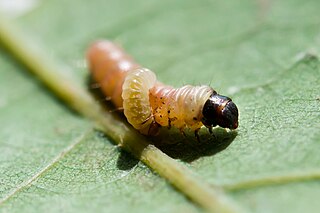
Lepidoptera is an order of insects that includes butterflies and moths. About 180,000 species of the Lepidoptera are described, in 126 families and 46 superfamilies, 10 percent of the total described species of living organisms. It is one of the most widespread and widely recognizable insect orders in the world. The Lepidoptera show many variations of the basic body structure that have evolved to gain advantages in lifestyle and distribution. Recent estimates suggest the order may have more species than earlier thought, and is among the four most species-rich orders, along with the Hymenoptera, Diptera, and Coleoptera.

Moths are a group of insects that includes all members of the order Lepidoptera that are not butterflies. They were previously classified as suborder Heterocera, but the group is paraphyletic with respect to butterflies and neither subordinate taxa are used in modern classifications. Moths make up the vast majority of the order. There are thought to be approximately 160,000 species of moth, many of which have yet to be described. Most species of moth are nocturnal, although there are also crepuscular and diurnal species.

The Gelechiidae are a family of moths commonly referred to as twirler moths or gelechiid moths. They are the namesake family of the huge and little-studied superfamily Gelechioidea, and the family's taxonomy has been subject to considerable dispute. These are generally very small moths with narrow, fringed wings. The larvae of most species feed internally on various parts of their host plants, sometimes causing galls. Douglas-fir (Pseudotsuga) is a host plant common to many species of the family, particularly of the genus Chionodes, which as a result is more diverse in North America than usual for Gelechioidea.

Crambidae comprises the grass moth family of lepidopterans. They are variable in appearance, with the nominal subfamily Crambinae taking up closely folded postures on grass stems where they are inconspicuous, while other subfamilies include brightly coloured and patterned insects that rest in wing-spread attitudes.

The Pyraloidea are a moth superfamily containing about 16,000 described species worldwide, and probably at least as many more remain to be described. They are generally fairly small moths, and as such, they have been traditionally associated with the paraphyletic Microlepidoptera.

Depressariidae is a family of moths. It was formerly treated as a subfamily of Gelechiidae, but is now recognised as a separate family, comprising about 2,300 species worldwide.
Epiborkhausenites is an extinct genus of moth in the concealer moth family Oecophoridae and containing a single species Epiborkhausenites obscurotrimaculatus. The species is known only from Middle Eocene, Bartonian stage, Baltic amber deposits near the town of Palanga in Lithuania.

Psilocorsis cryptolechiella is a moth of the family Depressariidae. It is found in the United States, including Alabama, Illinois, Massachusetts, Pennsylvania and South Carolina.

Psilocorsis quercicella is a species of moth of the family Depressariidae. It is found in the United States, including Florida, Maryland, Massachusetts and Oklahoma.

Psilocorsis is a genus of moths of the family Depressariidae.
Psilocorsis argyropasta is a moth in the family Depressariidae. It was described by Walsingham in 1912. It is found in Mexico.
Psilocorsis propriella is a moth in the family Depressariidae. It was described by Zeller in 1877. It is found in Colombia.
Psilocorsis purpurascens is a moth in the family Depressariidae. It was described by Walsingham in 1912. It is found in Guatemala.
Psilocorsis amydra is a moth in the family Depressariidae. It was described by Ronald W. Hodges in 1961. It is found in North America, where it has been recorded from Arizona.
Psilocorsis arguta is a moth in the family Depressariidae. It was described by Ronald W. Hodges in 1961. It is found in North America, where it has been recorded from Arizona.
Psilocorsis cirrhoptera is a moth in the family Depressariidae. It was described by Ronald W. Hodges in 1961. It is found in North America, where it has been recorded from Arizona.
Psilocorsis fatula is a moth in the family Depressariidae. It was described by Ronald W. Hodges in 1975. It is found in North America, where it has been recorded from Texas.
Psilocorsis carpocapsella is a moth in the family Depressariidae. It was described by Francis Walker in 1864. It is found in Brazil.
Psilocorsis melanophthalma is a moth in the family Depressariidae. It was described by Edward Meyrick in 1928. It is found in Colombia.
Psilocorsis minerva is a moth in the family Depressariidae. It was described by Edward Meyrick in 1928. It is found in Colombia.








